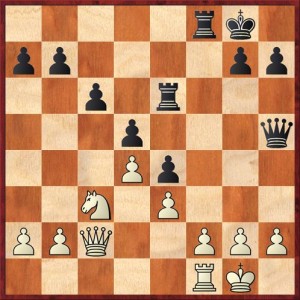You know you’re at a Jerry Weikel tournament when…
Before round 1, he gets on the microphone and says, “You have just left the planet.” This invariably comes after he tells all the players to turn off their cell phones.
He also tells us, “Remember to first mark your result on the wall chart, and then show your opponent how you had him crushed just before he checkmated you.” Amazingly, that joke gets a laugh every year, even though I’m sure that by now everyone expects it.
Sergei Kudrin is on board one and Alexander Ivanov is on board two. Occasionally Jerry gets other big-name players, such as the year that Loek van Wely showed up, but Kudrin and Ivanov are definitely the two grandmasters whom you can count on to play in a Reno tournament.
On the other hand, there are some subtle changes this time. First, the name of the tournament itself is different. For many years, GM Larry Evans would come to the Reno tournaments and give lectures, simuls, or free analysis between rounds. But he has now passed away, and this year’s tournament is the first one to be named in his honor.
The tidal wave of youth in the open section continues, which is a great thing to see. Jerry Weikel has a new granddaughter, who came to the tournament in her mother’s arms. I fully expect her to be playing in the tournament next year! (Okay, all right, I’ll give her two years.)
And in something that is both old and new at the same time, Michael Aigner is back! This is his first competitive tournament in two years, during which time he has been battling some serious medical problems. He told me he is still not feeling a lot better, but he is just playing through it.
I scored 1½ points in the first two rounds, with a draw against a young class-A player and a nice win against a class-A player who is closer to my age. I was disappointed with the first game because the draw was completely self-inflicted. My opponent offered a draw just as the game was about to get really hairy. Unfortunately I was at that point down to 13 minutes for 19 moves, and I really did not trust my ability to get through the time scramble, so I accepted the offer.
But I made up for it with a smooth performance in round two. No time trouble, plus… I got a chance to play the Fischer rook sacrifice for the first time in my career! I refer, of course, to Fischer’s 19. Rf6!! against Pal Benko in the 1963 U.S. championship.
Here’s the position from my game:
Of course, Black is already up an exchange, so just about anything would win. I didn’t want to play a flashy brilliancy just for the sake of playing a brilliancy — I wanted to play the best moves. That being said, I think that the line I chose was best. I played 22. … Rh6 (setting up the combination) 23. h3 (forced) Rf3! and White resigned. Of course, if White plays 24. gf then 24. … Qxh3 leads to mate next move. On anything else — even knight sacrifices on d5/e4 — Black plays 24. … Rxh3 with unstoppable mate threats.
Of course, my sac isn’t even close to being in the same league as Fischer’s, but it was a nice way to finish the game.
The PGN of the whole game is below if you’re interested.




{ 2 comments… read them below or add one }
Thanks for the tournament reports Dana, I really enjoy these – especially the Reno reports.
Sorry to hear that fpawn is still not feeling so great. But its good to see him mixing it up again. Hey, maybe he did a tournament report – cu 🙂
“On anything else — even knight sacrifices on d5/e4 — Black plays 24. … Rxh3 with unstoppable mate threats.”
Not true. After 24. Nxe4! Rxh3 25. f4! Rh1+ 26. Kf2 Rxf1+ 27. Kxf1 dxe4 28. Qxe4, there’s still some work to do.